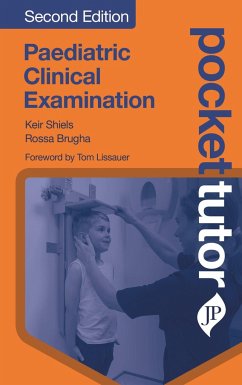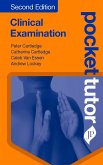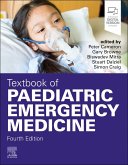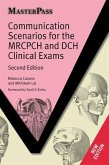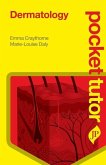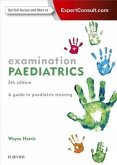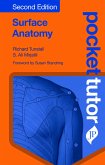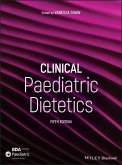- Broschiertes Buch
- Merkliste
- Auf die Merkliste
- Bewerten Bewerten
- Teilen
- Produkt teilen
- Produkterinnerung
- Produkterinnerung
Pocket Tutor Paediatric Clinical Examination is an indispensable guide to the examination of children, a challenging part of clinical practice for medical students and junior doctors as it involves dealing with newborn babies through to teenagers (often also the childâ s parents or guardians) and requires different communication skills and knowledge.
Andere Kunden interessierten sich auch für
![Pocket Tutor Clinical Examination Pocket Tutor Clinical Examination]() Peter CartledgePocket Tutor Clinical Examination39,99 €
Peter CartledgePocket Tutor Clinical Examination39,99 €![Textbook of Paediatric Emergency Medicine Textbook of Paediatric Emergency Medicine]() Textbook of Paediatric Emergency Medicine94,99 €
Textbook of Paediatric Emergency Medicine94,99 €![Communication Scenarios for the MRCPCH and DCH Clinical Exams Communication Scenarios for the MRCPCH and DCH Clinical Exams]() Rebecca CasansCommunication Scenarios for the MRCPCH and DCH Clinical Exams58,99 €
Rebecca CasansCommunication Scenarios for the MRCPCH and DCH Clinical Exams58,99 €![Pocket Tutor Dermatology Pocket Tutor Dermatology]() Emma CraythornePocket Tutor Dermatology39,99 €
Emma CraythornePocket Tutor Dermatology39,99 €![Examination Paediatrics Examination Paediatrics]() Wayne Harris (West Moreton Senior Staff Specialist in PaediatricsExamination Paediatrics63,99 €
Wayne Harris (West Moreton Senior Staff Specialist in PaediatricsExamination Paediatrics63,99 €![Pocket Tutor Surface Anatomy Pocket Tutor Surface Anatomy]() Richard TunstallPocket Tutor Surface Anatomy39,99 €
Richard TunstallPocket Tutor Surface Anatomy39,99 €![Clinical Paediatric Dietetics Clinical Paediatric Dietetics]() V ShawClinical Paediatric Dietetics123,99 €
V ShawClinical Paediatric Dietetics123,99 €-
-
-
Pocket Tutor Paediatric Clinical Examination is an indispensable guide to the examination of children, a challenging part of clinical practice for medical students and junior doctors as it involves dealing with newborn babies through to teenagers (often also the childâ s parents or guardians) and requires different communication skills and knowledge.
Produktdetails
- Produktdetails
- Pocket Tutor
- Verlag: JP Medical Ltd
- 2 Revised edition
- Seitenzahl: 304
- Erscheinungstermin: 31. August 2019
- Englisch
- Abmessung: 178mm x 114mm x 14mm
- Gewicht: 324g
- ISBN-13: 9781909836891
- ISBN-10: 1909836893
- Artikelnr.: 56846676
- Herstellerkennzeichnung
- Libri GmbH
- Europaallee 1
- 36244 Bad Hersfeld
- gpsr@libri.de
- Pocket Tutor
- Verlag: JP Medical Ltd
- 2 Revised edition
- Seitenzahl: 304
- Erscheinungstermin: 31. August 2019
- Englisch
- Abmessung: 178mm x 114mm x 14mm
- Gewicht: 324g
- ISBN-13: 9781909836891
- ISBN-10: 1909836893
- Artikelnr.: 56846676
- Herstellerkennzeichnung
- Libri GmbH
- Europaallee 1
- 36244 Bad Hersfeld
- gpsr@libri.de
Kier Shiels MA MB BChir MRCPCH MAcadMEd, Specialty Registrar in Paediatrics, Barking, Havering & Redbridge University Hospitals NHS Trust, London, UK. Rossa Brugha BMBCh MA(Oxon) MRCPCH PhD, Academic Clinical Lecturer, Imperial College London, London, UK
Chapter 1. History taking. 1.1. Algorithmic thinking. 1.2. Preparation.
1.3. Communication. 1.4. Components of the paediatric history. 1.5. Red
Flags. Chapter 2. Examination of a newborn. 2.1. Clinical scenarios. 2.2
Pregnancy history. 2.3. Development and delivery. 2.4. Examination of the
newborn. Chapter 3. Examination of a child. 3.1. Recognising the sick
child. 3.2. Examining a child. 3.3. Chaperones. Chapter 4. Growth and
nutrition. 4.1. Clinical scenarios. 4.2. Common presentations. 4.3.
Examination of growth. 4.4. Examination of pubertal status. 4.5. Summary.
Chapter 5. Developmental assessment. 5.1. Clinical scenarios. 5.2.
Common presentations. 5.2. Developmental milestones. 5.3. Developmental
assessment. 5.4 Summary. Chapter 6. The respiratory system. 6.1.
Clinical scenarios. 6.2. Common presentations. 6.3. Respiratory
examination. 6.4. Summary. Chapter 7. The cardiovascular system. 7.1.
Clinical scenarios. 7.2. Common presentations. 7.3. Cardiac examination.
7.4. Summary. Chapter 8. The abdomen. 8.1. Clinical scenarios. 8.2.
Common presentations. 8.3. Abdominal examination. 8.4. Summary. Chapter
9. The nervous system. 9.1 Clinical Scenarios. 9.2 Common presentations.
9.3. Neurological history. 9.4. Cranial nerve examination. 9.5.
Peripheral nerve examination. 9.6. Summary. Chapter 10. Bones, joints and
muscles. 10.1. Clinical scenarios. 10.2. Common presentations. 10.3.
Musculoskeletal examination. 10.4. Summary. Chapter 11. The head and
neck. 11.1. Clinical scenarios. 11.2. Common presentations. 11.3.
Examination of the mouth and throat. 11.4. Examination of the ears and
nose. 11.5. Examination of neck lumps. 11.6. Summary. Chapter 12. Skin
and rashes. 12.1. Clinical scenarios. 12.2. Common presentations. 12.3.
Examination of the skin. 12.4. Summary. Chapter 13. Abnormal behaviour.
13.1. Clinical scenarios. 13.2. Common presentations. 13.3. Behavioural
examination. 13.4. Sleep history and examination. 13.5 Summary. Chapter
14. Genetic disorders and syndromes. 14.1. Clinical scenarios. 14.2.
Common genetic syndromes. 14.3. Examination for genetic syndromes. 14.4.
Summary.
1.3. Communication. 1.4. Components of the paediatric history. 1.5. Red
Flags. Chapter 2. Examination of a newborn. 2.1. Clinical scenarios. 2.2
Pregnancy history. 2.3. Development and delivery. 2.4. Examination of the
newborn. Chapter 3. Examination of a child. 3.1. Recognising the sick
child. 3.2. Examining a child. 3.3. Chaperones. Chapter 4. Growth and
nutrition. 4.1. Clinical scenarios. 4.2. Common presentations. 4.3.
Examination of growth. 4.4. Examination of pubertal status. 4.5. Summary.
Chapter 5. Developmental assessment. 5.1. Clinical scenarios. 5.2.
Common presentations. 5.2. Developmental milestones. 5.3. Developmental
assessment. 5.4 Summary. Chapter 6. The respiratory system. 6.1.
Clinical scenarios. 6.2. Common presentations. 6.3. Respiratory
examination. 6.4. Summary. Chapter 7. The cardiovascular system. 7.1.
Clinical scenarios. 7.2. Common presentations. 7.3. Cardiac examination.
7.4. Summary. Chapter 8. The abdomen. 8.1. Clinical scenarios. 8.2.
Common presentations. 8.3. Abdominal examination. 8.4. Summary. Chapter
9. The nervous system. 9.1 Clinical Scenarios. 9.2 Common presentations.
9.3. Neurological history. 9.4. Cranial nerve examination. 9.5.
Peripheral nerve examination. 9.6. Summary. Chapter 10. Bones, joints and
muscles. 10.1. Clinical scenarios. 10.2. Common presentations. 10.3.
Musculoskeletal examination. 10.4. Summary. Chapter 11. The head and
neck. 11.1. Clinical scenarios. 11.2. Common presentations. 11.3.
Examination of the mouth and throat. 11.4. Examination of the ears and
nose. 11.5. Examination of neck lumps. 11.6. Summary. Chapter 12. Skin
and rashes. 12.1. Clinical scenarios. 12.2. Common presentations. 12.3.
Examination of the skin. 12.4. Summary. Chapter 13. Abnormal behaviour.
13.1. Clinical scenarios. 13.2. Common presentations. 13.3. Behavioural
examination. 13.4. Sleep history and examination. 13.5 Summary. Chapter
14. Genetic disorders and syndromes. 14.1. Clinical scenarios. 14.2.
Common genetic syndromes. 14.3. Examination for genetic syndromes. 14.4.
Summary.
Chapter 1. History taking. 1.1. Algorithmic thinking. 1.2. Preparation.
1.3. Communication. 1.4. Components of the paediatric history. 1.5. Red
Flags. Chapter 2. Examination of a newborn. 2.1. Clinical scenarios. 2.2
Pregnancy history. 2.3. Development and delivery. 2.4. Examination of the
newborn. Chapter 3. Examination of a child. 3.1. Recognising the sick
child. 3.2. Examining a child. 3.3. Chaperones. Chapter 4. Growth and
nutrition. 4.1. Clinical scenarios. 4.2. Common presentations. 4.3.
Examination of growth. 4.4. Examination of pubertal status. 4.5. Summary.
Chapter 5. Developmental assessment. 5.1. Clinical scenarios. 5.2.
Common presentations. 5.2. Developmental milestones. 5.3. Developmental
assessment. 5.4 Summary. Chapter 6. The respiratory system. 6.1.
Clinical scenarios. 6.2. Common presentations. 6.3. Respiratory
examination. 6.4. Summary. Chapter 7. The cardiovascular system. 7.1.
Clinical scenarios. 7.2. Common presentations. 7.3. Cardiac examination.
7.4. Summary. Chapter 8. The abdomen. 8.1. Clinical scenarios. 8.2.
Common presentations. 8.3. Abdominal examination. 8.4. Summary. Chapter
9. The nervous system. 9.1 Clinical Scenarios. 9.2 Common presentations.
9.3. Neurological history. 9.4. Cranial nerve examination. 9.5.
Peripheral nerve examination. 9.6. Summary. Chapter 10. Bones, joints and
muscles. 10.1. Clinical scenarios. 10.2. Common presentations. 10.3.
Musculoskeletal examination. 10.4. Summary. Chapter 11. The head and
neck. 11.1. Clinical scenarios. 11.2. Common presentations. 11.3.
Examination of the mouth and throat. 11.4. Examination of the ears and
nose. 11.5. Examination of neck lumps. 11.6. Summary. Chapter 12. Skin
and rashes. 12.1. Clinical scenarios. 12.2. Common presentations. 12.3.
Examination of the skin. 12.4. Summary. Chapter 13. Abnormal behaviour.
13.1. Clinical scenarios. 13.2. Common presentations. 13.3. Behavioural
examination. 13.4. Sleep history and examination. 13.5 Summary. Chapter
14. Genetic disorders and syndromes. 14.1. Clinical scenarios. 14.2.
Common genetic syndromes. 14.3. Examination for genetic syndromes. 14.4.
Summary.
1.3. Communication. 1.4. Components of the paediatric history. 1.5. Red
Flags. Chapter 2. Examination of a newborn. 2.1. Clinical scenarios. 2.2
Pregnancy history. 2.3. Development and delivery. 2.4. Examination of the
newborn. Chapter 3. Examination of a child. 3.1. Recognising the sick
child. 3.2. Examining a child. 3.3. Chaperones. Chapter 4. Growth and
nutrition. 4.1. Clinical scenarios. 4.2. Common presentations. 4.3.
Examination of growth. 4.4. Examination of pubertal status. 4.5. Summary.
Chapter 5. Developmental assessment. 5.1. Clinical scenarios. 5.2.
Common presentations. 5.2. Developmental milestones. 5.3. Developmental
assessment. 5.4 Summary. Chapter 6. The respiratory system. 6.1.
Clinical scenarios. 6.2. Common presentations. 6.3. Respiratory
examination. 6.4. Summary. Chapter 7. The cardiovascular system. 7.1.
Clinical scenarios. 7.2. Common presentations. 7.3. Cardiac examination.
7.4. Summary. Chapter 8. The abdomen. 8.1. Clinical scenarios. 8.2.
Common presentations. 8.3. Abdominal examination. 8.4. Summary. Chapter
9. The nervous system. 9.1 Clinical Scenarios. 9.2 Common presentations.
9.3. Neurological history. 9.4. Cranial nerve examination. 9.5.
Peripheral nerve examination. 9.6. Summary. Chapter 10. Bones, joints and
muscles. 10.1. Clinical scenarios. 10.2. Common presentations. 10.3.
Musculoskeletal examination. 10.4. Summary. Chapter 11. The head and
neck. 11.1. Clinical scenarios. 11.2. Common presentations. 11.3.
Examination of the mouth and throat. 11.4. Examination of the ears and
nose. 11.5. Examination of neck lumps. 11.6. Summary. Chapter 12. Skin
and rashes. 12.1. Clinical scenarios. 12.2. Common presentations. 12.3.
Examination of the skin. 12.4. Summary. Chapter 13. Abnormal behaviour.
13.1. Clinical scenarios. 13.2. Common presentations. 13.3. Behavioural
examination. 13.4. Sleep history and examination. 13.5 Summary. Chapter
14. Genetic disorders and syndromes. 14.1. Clinical scenarios. 14.2.
Common genetic syndromes. 14.3. Examination for genetic syndromes. 14.4.
Summary.

